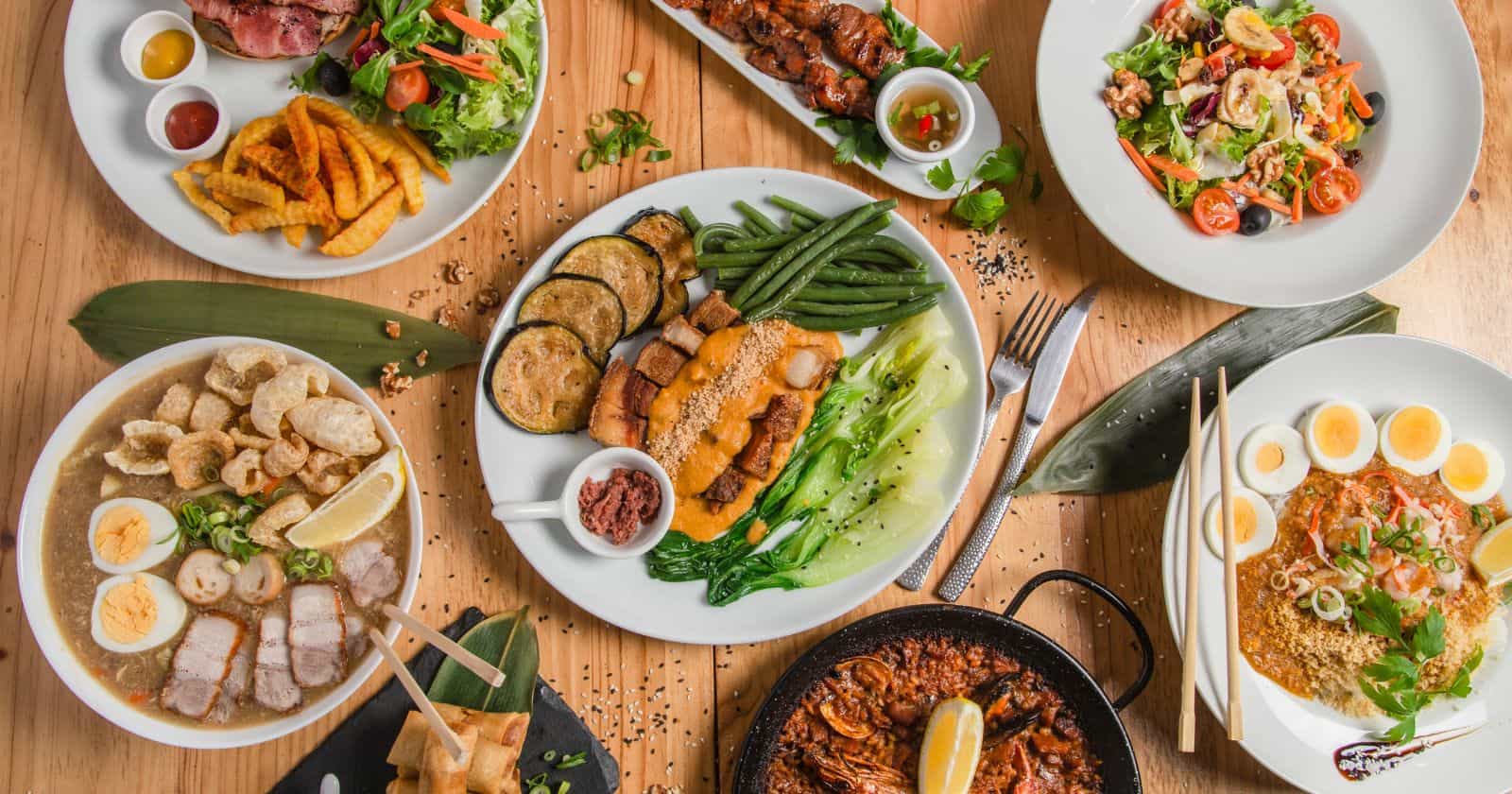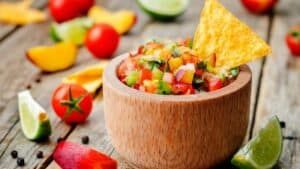You bite into a freshly made tamale, savoring the moist corn masa and rich filling. Or maybe you slurp up a bowl of pozole, the hearty hominy and pork stew warming you on a chilly day. If you love Mexican food, many of your favorite comfort foods likely originate from indigenous traditions, blended with Spanish colonial influences.
Now, picture yourself in the Philippines, wrapping your fork into a mound of garlic fried rice, topped with savory adobo chicken stew. As you enjoy the complex flavors, you begin noticing parallels to the Mexican dishes you know and love.
Mexican and Filipino cuisines may seem oceans apart. But a shared history of Spanish rule brought surprising connections between these vibrant food cultures.
In this article, we’ll uncover the cross-cultural influences that shape two unique yet kindred culinary traditions. You’ll discover the staple ingredients, cooking methods, and iconic dishes that reveal the bond between Filipino and Mexican food.
Let’s explore the fusion of Latin American and Asian flavors hidden in every tasty bite!
Blending Traditions Through Centuries of Change
How did two distant cuisines end up with such unlikely similarities? The answer lies in the sweeping impacts of Spanish colonialism.
From the 16th to 19th century, Spain ruled over Mexico and the Philippines. This introduced European ingredients and cooking techniques that forever transformed native foodways.
The Spanish brought livestock animals, rice paddies, produce like tomatoes and garlic, and baking methods. Locals incorporated these new foods and cooking styles into traditional dishes.
This cultural convergence created Mexican and Filipino cuisine as we know them today. Though each retained its unique flair, the Spanish influence connects them through shared ingredients and techniques.
So next time you bite into a tamale or stir-fry some garlic rice, remember the centuries of blended traditions in every tasty morsel!
Kindred Spices and Flavors
With their warm climates and cultural overlaps, it’s no wonder Mexican and Filipino cuisines share some key seasonings. Let’s look at some of their common spices and flavor profiles:
Chili Peppers
No discussion of Mexican food is complete without mentioning chili peppers! From tangy tomatillos to fiery habaneros, dozens of chili varieties add sizzle to salsas, stews, and street eats.
Similarly, spicy peppers like siling labuyo permeate Filipino cooking. They lend heat to staples like the pork blood stew dinuguan. Chili flakes also provide a kick to vinegar dipping sauces.
For both cuisines, chili peppers add that crucial flavor dimension. Their heat balances and rounds out the other ingredients.
Garlic and Onions
These aromatic vegetables form the base for countless Mexican and Filipino dishes.
In Mexican cooking, garlic and onions sauté in oil to start flavors developing before other ingredients hit the pan. Think of the holy trinity of onions, garlic, and tomatoes that creates depth in sauce bases.
Meanwhile in the Philippines, garlic and onions join forces with vinegar, soy sauce, and black pepper in the quintessential marinade called adobo. Their savory flavor builds a complex foundation of tastes.
Fresh Herbs and Citrus
Brighter flavors also connect Mexican and Filipino food. Abundant fresh herbs like cilantro and scallions add a pop of flavor and aroma.
And both cuisines rely on zesty citrus. In Mexico, a squeeze of lime elevates tacos, ceviche, and aguas frescas. In the Philippines, calamansi juice brightens up marinades and dipping sauces.
These fresh components keep each bite lively. They cut through richer flavors and help balance the heat.
Savory and Bold
Beyond specific ingredients, Mexican and Filipino cuisine share a deep and savory flavor profile. There’s a mastery of developing complex layers using meats, spices, vegetables, and time.
Filipino stews like caldereta and mechado feature tomato- or vinegar-based sauces simmered to perfection. The same goes for Mexican moles and adobos, where patient cooking builds intricate flavor.
And savory street snacks like chorizo and isaw mean both cuisines excel at maximizing flavor in small bites. There’s no need to be timid with the seasonings!
Shared Comfort Foods and Cooking Methods
Beyond abstract flavors, some dishes with common roots anchor Mexican and Filipino cuisine. Many emerged under Spanish rule, though each culture made them uniquely their own.
Let’s explore some of their classic comfort foods and staple cooking techniques.
Adobo
While both cuisines include adobo, the preparation varies:
- In Mexico, adobo is a tangy chili-based marinade for meats.
- In the Philippines, adobo is a cooking process, simmering meat in vinegar, soy sauce, garlic, and peppercorns.
Still, the ethos of deepening flavor through patient stewing remains.
Tamales
These hearty masa snacks come in different regional forms:
- Mexican tamales feature corn dough with meat, cheese, or veggies inside a corn husk.
- Filipino tamales use rice dough instead, sometimes wrapped in banana leaves.
But both capture that satisfying masa mouthfeel.
Grilling
An open flame adds char and depth to meats and veggies alike.
- In Mexico, grilled carne asada and pollo asado are classics.
- In the Philippines, bold pork skewers like inihaw baboy spotlight grilling.
Stir-Frying
Quick skillet cooking retains texture and freshness.
- Mexico uses stir-frying for tacos al pastor and some veggie sides.
- The Philippines stir-fries noodle dishes, omelets, and meats.
The technique adds a lively sizzle to any meal!
Steaming
Gentle steaming preserves delicate flavors:
- Tamales, of course, are an iconic steamed Mexican dish.
- In the Philippines, steamed rice cakes called puto add subtle sweetness to meals.
Celebrating Shared Staple Ingredients
At the core of these dishes are several miraculous staples that define Filipino and Mexican cooking. Let’s look at three key ingredients they have in common.
Rice
A meal without rice seems nearly unthinkable in both cultures!
Long-grain white rice supplies the canvas for rich stews, flavorful proteins, and tangy sauces in everyday cooking.
Rice also goes beyond a side dish in snacks like arroz con leche or champorado (rice porridges). It’s a versatile grain that’s an irreplaceable part of each cuisine.
Corn
From sweet kernels toground masa, corn is essential to both Mexican and Filipino food.
In Mexico, corn anchors dishes like tamales, tortillas, pozole, and esquites. Meanwhile in the Philippines, certain regions use corn as an everyday carb instead of rice.
Plus, unique local varieties like Mexican huitlacoche (corn smut) demonstrate corn’s versatility.
Coconuts
Coconuts add texture and rich flavor to both cuisines.
Shredded coconut garnishes Filipino desserts, while coconut milk creates the base for stews like ginataang manok.
In Mexico, coconut features in regional cooking, like shrimp simmered in coconut milk. Sweet coconut rice puddings also showcase its flavor.
Coconuts are the ultimate local crop, used from flesh to water to milk!
Digging Deeper Into Shared Dishes
Earlier we explored basic shared dishes like tamales and adobo. Now let’s zoom in on a few classics and uncover their unique regional forms.
Menudo
This stew’s comforting flavor transcends borders, but with different approaches:
- Mexico: Menudo contains beef tripe and hominy in a red chili broth.
- Philippines: Menudo uses pork liver, carrots, and potatoes in a tomato sauce.
Empanadas
These handheld snacks encase all sorts of savory and sweet fillings:
- Mexico: Empanadas are made with corn masa and filled with meats, cheese, or greens.
- Philippines: Empanadas use a pastry crust and contain ground meat or sweet fillings like ube (purple yam).
Halo-Halo
A blizzard of flavors makes this sweet treat so addictive:
- Mexico: Raspados feature mounds of shaved ice covered with fruit syrups and condensed milk.
- Philippines: Halo-halo layers shaved ice with canned fruits, beans, jellies, and ice cream.
It’s incredible how one dish can have so many interpretations!
Embracing the Gift of Shared Flavors
As a food lover, discovering these connections between Mexican and Filipino cuisine may give you a new appreciation for their cultural story.
Despite geography, the shared legacy of Spanish colonial rule created surprising links between the foods we love. From staple ingredients to cooking techniques, the cuisines retain parallel spirits while remaining unique.
This shared foundation doesn’t diminish their individuality, though. Instead, it’s a gift allowing us to savor more than one food tradition can offer.
So next time you grab lunch or cook up some comfort food, consider taking a mini world tour! Try venturing beyond your go-to cuisine to experience more of what these kindred cultures have to offer.
Let Mexican and Filipino flavors tell their story through every appetizing bite. And remember the centuries of blended tradition that shaped two distinct cuisines into extended food families.





